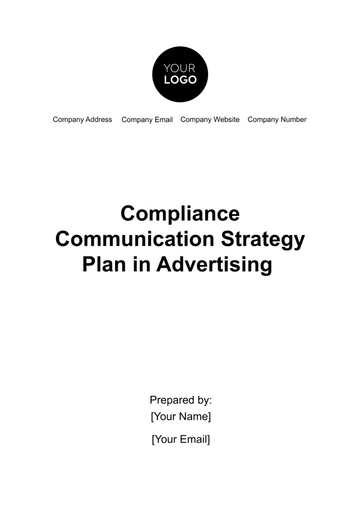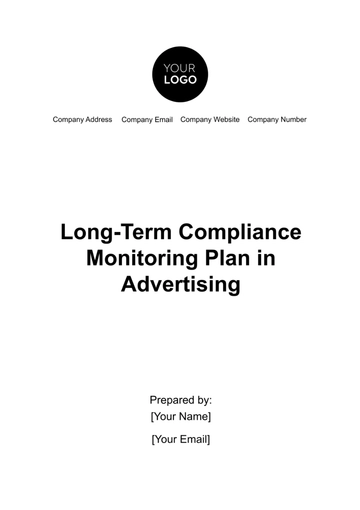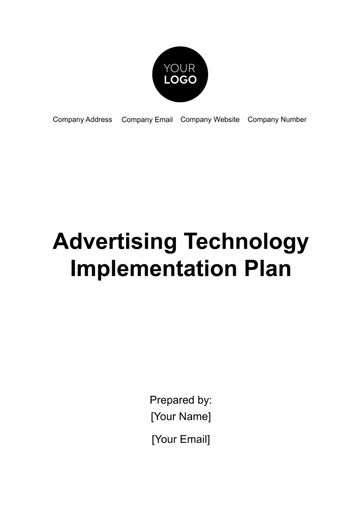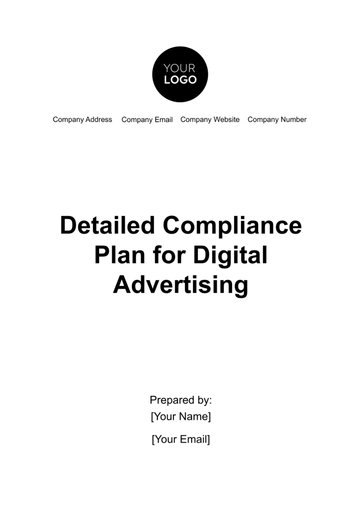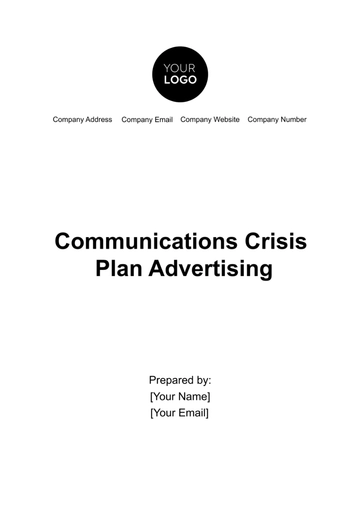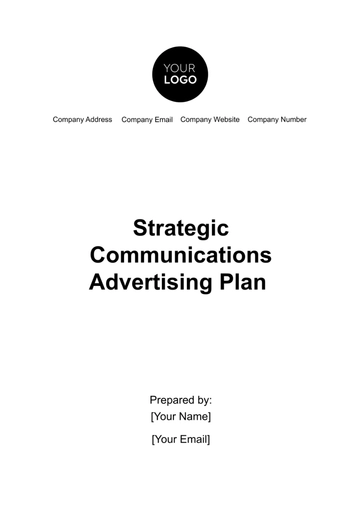Free Communications Crisis Plan Advertising
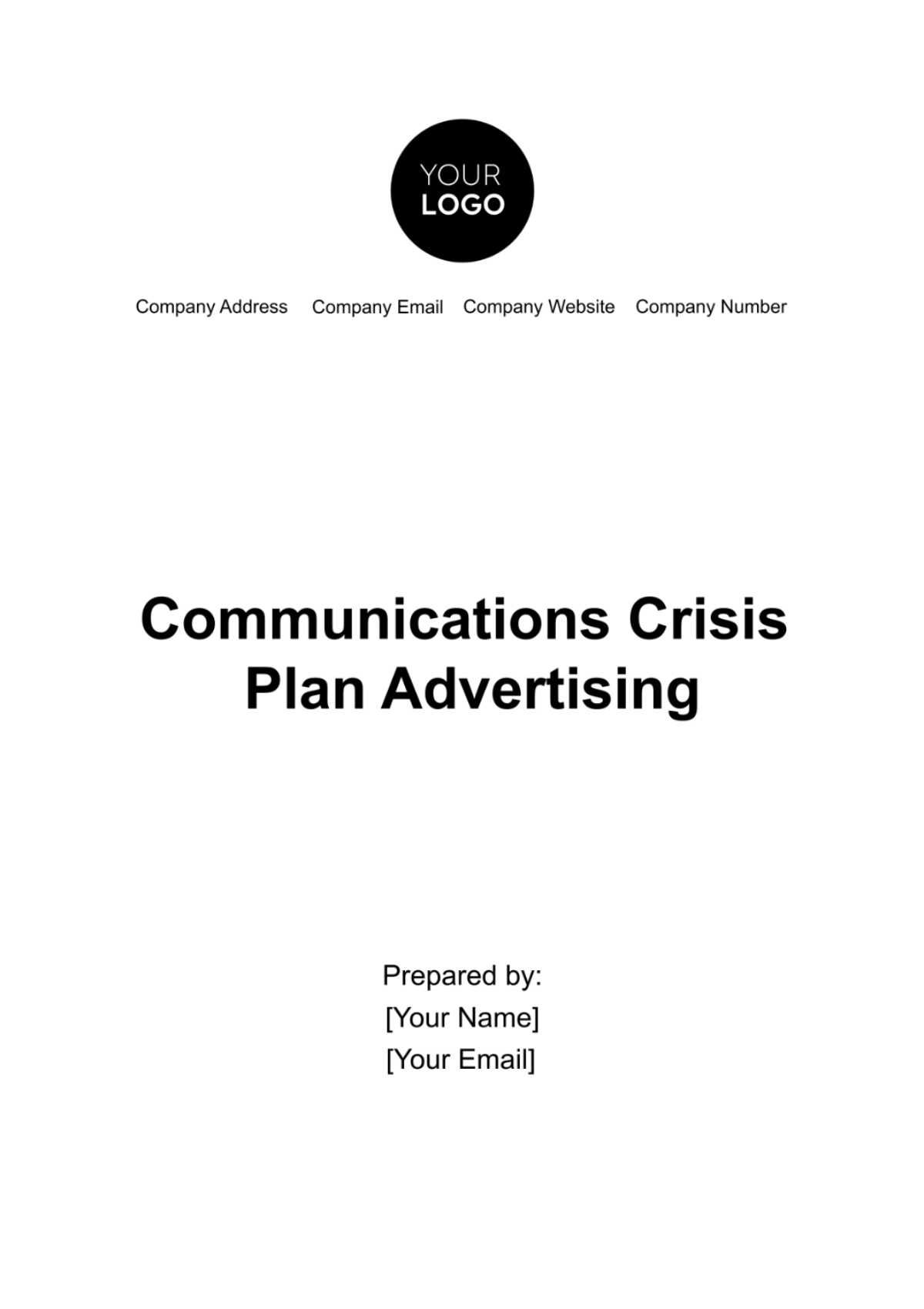
I. Introduction
A. Purpose of the Plan
The Communications Crisis Plan for [Your Organization Name] is a meticulously crafted framework designed to guide the organization through effective communication during challenging times, particularly within the advertising context. By delineating roles, strategies, and protocols, the plan aims to fortify the organization's ability to respond swiftly and decisively to crises, safeguarding its reputation and maintaining public trust. Emphasizing the strategic importance of communication, this plan aligns with overarching organizational goals, ensuring resilience and adaptability in the face of adversity.
B. Scope
This plan is comprehensive, addressing the unique challenges presented by crises within the advertising landscape. Encompassing scenarios such as misleading content, controversial associations, and social media backlash, the plan offers tailored strategies to mitigate the impact on advertising campaigns. By recognizing the intricate interplay between advertising and crisis communication, the plan ensures a holistic approach, allowing for nuanced responses that resonate with stakeholders. The scope extends beyond crisis response, fostering a proactive culture that anticipates potential challenges and incorporates strategic communication seamlessly into advertising efforts.
II. Crisis Communication Team
A. Roles and Responsibilities
Crisis Communication Team Members:
1. [Your Name], Chief Marketing Officer (CMO):
Role: Provides strategic direction and oversight for communication efforts during a crisis.
Responsibilities: Decision-making on overarching communication strategies and alignment with organizational goals.
2. [Name], Director of Communications:
Role: Manages external communications and media relations.
Responsibilities: Crafting and disseminating crisis-related messages, maintaining positive relationships with media outlets.
3. [Name], Advertising Manager:
Role: Specialized in advertising strategies and content.
Responsibilities: Offers insights into advertising implications, assesses the impact of crises on advertising campaigns.
4. [Name], Legal Counsel:
Role: Ensures legal compliance in communication responses.
Responsibilities: Evaluates communication content for legal implications, guides on adherence to regulations.
5. [Name], Public Relations Specialist:
Role: Assists in crafting and disseminating crisis-related messages.
Responsibilities: Manages public perceptions, addresses concerns, and engages with stakeholders to maintain trust.
B. Contact Information
Ensure that all team members maintain up-to-date contact information. The primary point of contact during a crisis is [Designated Contact Person and Contact Information].
1. Primary Contact: [Designated Contact Person]
Contact Information: [Contact Details]
Responsibilities: Central point for crisis notifications, coordination, and decision-making.
2. Backup Contacts:
Contact Information: [Backup Contact Details]
Responsibilities: Ready to assume primary contact role if needed, ensuring 24/7 availability.
III. Pre-Crisis Preparation
A. Risk Assessment
Effective risk assessment is paramount to anticipatory crisis management. Identify potential advertising crises with a keen focus on the impact and likelihood of occurrences. Scrutinize scenarios such as misleading content, controversial associations, and social media backlash. A comprehensive understanding of these risks ensures a proactive approach, allowing the Crisis Communication Team to craft targeted and strategic responses, safeguarding the organization's reputation and brand integrity.
B. Messaging Strategy
The cornerstone of crisis communication lies in a well-crafted messaging strategy. Develop key messages that resonate with the brand's identity and values. Emphasize transparency, commitment to change, and responsiveness. Each message should address the specific concerns of stakeholders and align with the overall communication objectives. Crafting messages in alignment with these principles ensures clarity, consistency, and a genuine connection with the audience during times of adversity, fostering trust and understanding.
C. Stakeholder Analysis
Stakeholder analysis is a nuanced process that involves identifying and understanding the diverse groups that can be affected during a crisis. Customers, investors, employees, and media outlets play distinct roles in the advertising context. Tailor communication strategies to address the unique needs and concerns of each group. This targeted approach ensures that messages resonate effectively, mitigating potential damage and facilitating a smoother recovery process while maintaining positive relationships with key stakeholders.
D. Media Monitoring
Establishing a robust media monitoring system is essential for early crisis detection. Utilize tools such as social media listening, news outlet monitoring, and keyword alerts. These tools provide real-time insights into emerging issues, enabling swift response and containment. Timely identification of potential crises allows the Crisis Communication Team to proactively engage with the evolving situation, shaping narratives, and influencing public perceptions effectively, thereby minimizing the impact on the organization's advertising efforts.
IV. Crisis Response
A. Immediate Actions
In the initial moments of a crisis, swift and decisive actions are imperative. Notify the Crisis Communication Team immediately, triggering a coordinated response. The designated spokesperson, often the Chief Marketing Officer, assumes a central role. Immediate actions include assessing the severity, activating communication channels, and disseminating preliminary information. This rapid response sets the tone for the crisis management process, demonstrating organizational control, transparency, and a commitment to addressing the situation proactively.
B. Communication Channels
Identifying primary and secondary communication channels is critical for a comprehensive crisis response. The official website and social media platforms serve as primary channels for disseminating information directly to the public. Secondary channels, such as press releases and email communications, provide additional avenues for targeted messaging. A well-defined strategy for each channel ensures consistent, accurate, and timely communication, fostering transparency and trust in the organization's response during a crisis.
C. Internal Communication
Effective internal communication is foundational during a crisis, ensuring that employees are informed, reassured, and aligned with the organizational response. Conducting employee briefings, disseminating internal memos, and updating the intranet are key strategies. These internal communication efforts should convey accurate information, address potential concerns, and reinforce the organization's commitment to transparency. By keeping employees well-informed and engaged, internal cohesion is maintained, contributing to a unified and resilient organizational response.
D. External Communication
Crafting strategies for external communication involves addressing the public and media in a targeted and empathetic manner. Utilize press releases, social media updates, and media briefings to disseminate key messages. Transparency, authenticity, and a commitment to addressing concerns are paramount. Effective external communication mitigates reputational damage, facilitates stakeholder understanding, and positions the organization as proactive and responsible, contributing to the overall crisis resolution process.
E. Advertising Content Adjustments
In the face of a crisis, reviewing and modifying existing advertising content is crucial. Establish clear protocols for temporarily suspending or modifying advertising campaigns. This may involve a temporary suspension of campaigns, thorough reviews of content for alignment with crisis messaging, and potentially modifying content to address emerging concerns. These adjustments ensure that advertising efforts remain sensitive to the evolving crisis, minimizing negative impacts and preserving the organization's brand reputation.
V. Post-Crisis Evaluation
A. Debriefing
A post-crisis debriefing is a critical component of continuous improvement. The Crisis Communication Team conducts a thorough review of crisis events, assessing the effectiveness of response strategies. This includes a chronological overview of communication actions, an evaluation of key messages, and an identification of successes and challenges. The debriefing session serves as a forum for collective learning, enabling the team to distill valuable insights and identify areas for improvement in future crisis responses.
B. Documenting Lessons Learned
Documenting lessons learned from the crisis response is essential for refining future strategies. Evaluating the effectiveness of messaging, the timeliness of response, and specific areas for improvement provides a foundation for continuous enhancement. Insights gained from each crisis scenario contribute to an evolving repository of knowledge, enabling the Crisis Communication Team to adapt and improve strategies, protocols, and training initiatives for heightened preparedness in subsequent crises.
C. Continuous Improvement
Continuous improvement initiatives are integral to maintaining crisis management efficacy. Regular quarterly plan reviews involve reassessing the relevance of the plan, adjusting key messages, and refining protocols based on emerging trends. Annual team training exercises, including crisis simulation workshops and external expert sessions, enhance team preparedness and responsiveness. These initiatives ensure that the Crisis Communication Team remains agile, adaptive, and equipped to navigate the evolving landscape of potential crises effectively.
VI. Appendices
A. Contact Lists
Detailed and up-to-date contact lists are indispensable during a crisis. Provide comprehensive contact information for Crisis Communication Team members, legal counsel, and external PR agencies. Including backup contacts ensures continuity, and a clear delineation of responsibilities enhances efficiency. These contact lists, regularly updated and easily accessible, form a crucial component of the crisis management infrastructure, facilitating seamless communication and coordination.
B. Scenario-specific Protocols
Scenario-specific protocols offer detailed guidance for specific crisis scenarios. Whether addressing misleading content allegations or managing social media backlash, these protocols provide a roadmap for the Crisis Communication Team. Each protocol includes immediate response steps, communication strategies, and content adjustment procedures tailored to the unique challenges posed by the specific crisis scenario. Regular updates to these protocols ensure their relevance and effectiveness in addressing evolving communication challenges.
VII. Distribution and Accessibility
A. Distribution Plan
The distribution plan outlines how the crisis plan is disseminated to team members and relevant stakeholders. Utilize email distribution for regular updates and immediate crisis activations. An online document repository, accessible via a secure intranet or cloud-based storage, ensures 24/7 access to the most current version. This distribution plan enhances preparedness, providing the Crisis Communication Team with instant access to vital information, enabling swift and informed decision-making during crises.
B. Training
Ongoing training initiatives are pivotal for maintaining the Crisis Communication Team's readiness. Quarterly training sessions, including workshops, webinars, or in-person sessions, focus on emerging crisis trends and effective messaging strategies. Simulation exercises, conducted at least annually, simulate diverse crisis scenarios for practical responsiveness testing. These training initiatives ensure the team remains abreast of evolving challenges, hones their crisis management skills, and fosters a culture of continuous improvement within the organization.
- 100% Customizable, free editor
- Access 1 Million+ Templates, photo’s & graphics
- Download or share as a template
- Click and replace photos, graphics, text, backgrounds
- Resize, crop, AI write & more
- Access advanced editor
Introducing Template.net's Communications Crisis Plan Advertising Template. Easily editable and customizable using our Ai Editor Tool, this template offers a comprehensive solution for managing communication crises effectively. Safeguard your brand reputation with precise plans and strategies. Stay prepared and responsive in challenging situations with Template.net's innovative solutions.
You may also like
- Finance Plan
- Construction Plan
- Sales Plan
- Development Plan
- Career Plan
- Budget Plan
- HR Plan
- Education Plan
- Transition Plan
- Work Plan
- Training Plan
- Communication Plan
- Operation Plan
- Health And Safety Plan
- Strategy Plan
- Professional Development Plan
- Advertising Plan
- Risk Management Plan
- Restaurant Plan
- School Plan
- Nursing Home Patient Care Plan
- Nursing Care Plan
- Plan Event
- Startup Plan
- Social Media Plan
- Staffing Plan
- Annual Plan
- Content Plan
- Payment Plan
- Implementation Plan
- Hotel Plan
- Workout Plan
- Accounting Plan
- Campaign Plan
- Essay Plan
- 30 60 90 Day Plan
- Research Plan
- Recruitment Plan
- 90 Day Plan
- Quarterly Plan
- Emergency Plan
- 5 Year Plan
- Gym Plan
- Personal Plan
- IT and Software Plan
- Treatment Plan
- Real Estate Plan
- Law Firm Plan
- Healthcare Plan
- Improvement Plan
- Media Plan
- 5 Year Business Plan
- Learning Plan
- Marketing Campaign Plan
- Travel Agency Plan
- Cleaning Services Plan
- Interior Design Plan
- Performance Plan
- PR Plan
- Birth Plan
- Life Plan
- SEO Plan
- Disaster Recovery Plan
- Continuity Plan
- Launch Plan
- Legal Plan
- Behavior Plan
- Performance Improvement Plan
- Salon Plan
- Security Plan
- Security Management Plan
- Employee Development Plan
- Quality Plan
- Service Improvement Plan
- Growth Plan
- Incident Response Plan
- Basketball Plan
- Emergency Action Plan
- Product Launch Plan
- Spa Plan
- Employee Training Plan
- Data Analysis Plan
- Employee Action Plan
- Territory Plan
- Audit Plan
- Classroom Plan
- Activity Plan
- Parenting Plan
- Care Plan
- Project Execution Plan
- Exercise Plan
- Internship Plan
- Software Development Plan
- Continuous Improvement Plan
- Leave Plan
- 90 Day Sales Plan
- Advertising Agency Plan
- Employee Transition Plan
- Smart Action Plan
- Workplace Safety Plan
- Behavior Change Plan
- Contingency Plan
- Continuity of Operations Plan
- Health Plan
- Quality Control Plan
- Self Plan
- Sports Development Plan
- Change Management Plan
- Ecommerce Plan
- Personal Financial Plan
- Process Improvement Plan
- 30-60-90 Day Sales Plan
- Crisis Management Plan
- Engagement Plan
- Execution Plan
- Pandemic Plan
- Quality Assurance Plan
- Service Continuity Plan
- Agile Project Plan
- Fundraising Plan
- Job Transition Plan
- Asset Maintenance Plan
- Maintenance Plan
- Software Test Plan
- Staff Training and Development Plan
- 3 Year Plan
- Brand Activation Plan
- Release Plan
- Resource Plan
- Risk Mitigation Plan
- Teacher Plan
- 30 60 90 Day Plan for New Manager
- Food Safety Plan
- Food Truck Plan
- Hiring Plan
- Quality Management Plan
- Wellness Plan
- Behavior Intervention Plan
- Bonus Plan
- Investment Plan
- Maternity Leave Plan
- Pandemic Response Plan
- Succession Planning
- Coaching Plan
- Configuration Management Plan
- Remote Work Plan
- Self Care Plan
- Teaching Plan
- 100-Day Plan
- HACCP Plan
- Student Plan
- Sustainability Plan
- 30 60 90 Day Plan for Interview
- Access Plan
- Site Specific Safety Plan













